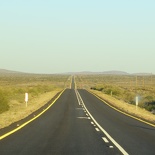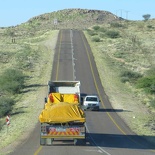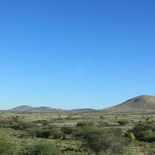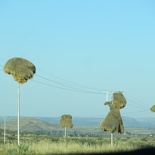Africa is a vast continent, and the country has an extensive network of cross-country roads serving various regions of the African continent. Much of Africa roads, especially between cities are connected via highways, where the accessibility from road outweighs that offered by trains.
While most inter-city trips via domestic plane are recommended, many towns and points of interests are not well connected to airport, where driving becomes the only mode of transport. On African highways out of cities, many of these roads are single lane two-way roads shared by vehicles of all sizes. The roads are mostly long straights for miles into the horizon. Unless the roads are newly paved, most are often littered with potholes, holes emphasized by the large temperature differences between the scorching day and freezing nights which makes the potholes larger. Larger vehicles tend to fair better over these bumps on the roads. Much of Africa’s freight are also transported via the road, so large 18 wheeler “road trains” spanning up to 3 trailers, like those in Australia are common on the roads here.
Driving etiquette
Unlike Singapore drivers, African drivers here are very considerate and will usually slow down or pull over completely for faster vehicles to overtake if they are holding back too many cars behind them, before continuing on themselves. Sometimes, trucks will simply just signal into the shoulder lane, telling you to overtake while giving you space to make a squeeze without going towards oncoming traffic. Horns are tapped once while overtaking where the driver being overtaken will slow down to let you pass. Flashing your hazard lights momentarily after passing is a way of saying Thanks to the driver behind.
Much of the vegetation here along the highways includes main shrubs and savanna trees, such as Mokala trees. Only lone power lines run along side without any phone reception between stations. Occasionally you will encounter a small town or two between stops, with no civilization or rest stops for tens to hundreds of kilometers at a go. Most part of the highway roads simply just roads without any signs of a telephone, rest stop, toilets, or even crash barriers when the road passes alongside a hillside or cliff. The roads at night are hazardous and pitch black, so driving at night is usually not recommended. The desert can get rather cold and icy at night, which can make driving in the early mornings before sunrise a hazardous affair.
The African outback views are stunning, the same can be said of their untouched scenery and magnificent sunsets in the evening. The views of the African savanna and the sun setting over the horizon is picture-perfect, just like having your “Lion king” moment.
Just be sure you are near a rest stop by then for the night.






